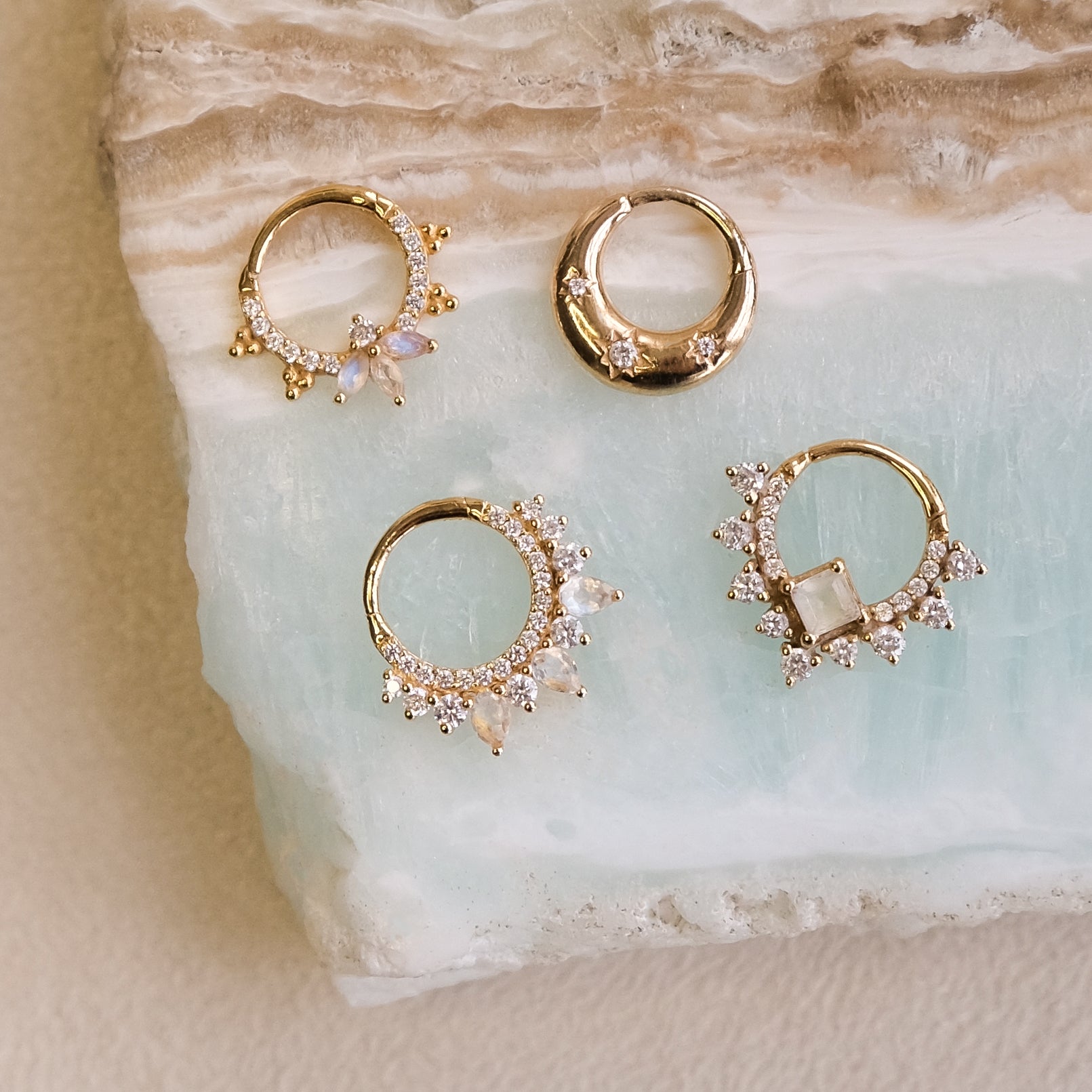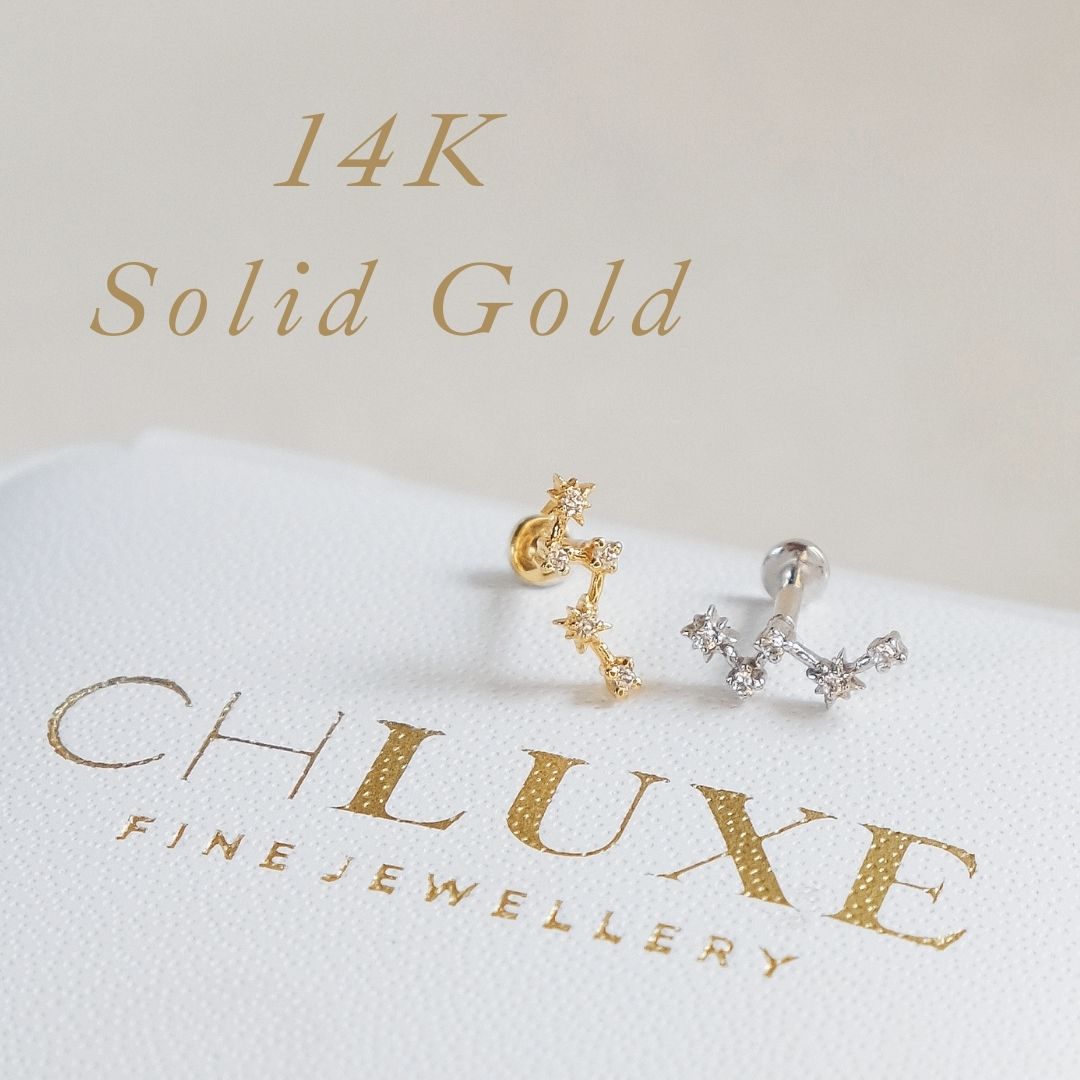The Complete Conch Piercing Size Guide
The rising trend of conch piercings speaks volumes about their charm and versatility. If you're toying with the idea of getting a conch piercing or are already sporting one, it's crucial to familiarise yourself with the sizes available to ensure comfort and visual appeal. In this detailed guide, we'll walk you through the A-Z of conch piercing sizes, covering an array of jewellery choices and tips for a smooth healing journey.
Anatomy and Placement:
Let's start with the basics—the anatomy of the conch and its positioning. Resembling a seashell, the conch is nestled in the middle portion of your ear's cartilage. Conch piercings can be placed in two primary areas: the inner conch (located closer to the centre of the ear) or the outer conch (towards the edge of the ear).
Jewellery Types for Conch Piercings:
When you get a conch piercing, it's usually done with a labret stud that's a bit longer than usual to accommodate any swelling during the healing process. Once your piercing is fully healed, you'll want to switch to a smaller size. The good news is the world of conch jewellery offers a delightful variety to suit all kinds of tastes and preferences. You'll find an abundance of options to explore! Among the popular choices are:
Labret Studs: Straight posts with a flat back and a decorative front, offering a more secure fit. (Check out some of our most popular labrets)
Clicker Hoops: Circular hoops with a hinge that "clicks" shut, making insertion and removal a breeze while maintaining a secure fit. (Discover our collection of hoops that are perfect for a conch piercing)
Sizing Considerations:
Choosing the perfect piece of jewellery for your conch piercing involves a few key considerations that differ slightly based on whether you're selecting a labret or a hoop. These factors include the gauge, length and design.
Labret Sizing:
Gauge: The gauge size refers to the thickness or diameter of the jewellery used for the rook piercing. It is denoted by a number followed by the letter "G," which stands for "gauge." The most common gauge sizes for labret studs in conch piercings are 16G (1.2mm) and 14G (1.6mm). The choice of gauge size often depends on the initial piercing process and personal preference.
Length: This refers to the length of the bar itself, and for conch piercings, it commonly ranges from 6mm (1/4") to 8mm (5/16"). An 8mm (5/16") labret is often used for conch piercings, but the most suitable length can depend on the thickness of your ear and the exact location of the piercing. The labret's length should provide enough space for your piercing to breathe, without causing unnecessary pressure or irritation.
Design: Labret studs come in various designs, with decorative ends like gemstones or unique shapes. When selecting a labret, consider your personal style and the occasions you're dressing for. A simple, minimalistic labret may be perfect for everyday wear, while a statement design could be your go-to for special events.
Hoop Sizing:
Gauge: Like labrets, the standard gauge sizes for hoops in conch piercings are 16G (1.2mm) and 14G (1.6mm). The appropriate gauge size would depend on the size of the piercing hole and your comfort.
Diameter: The diameter of your hoop should correspond with the thickness of your conch and your personal taste. Smaller diameters offer a snug, understated aesthetic, while larger diameters are more conspicuous and make a stronger statement.
Design: Hoops can be plain or feature decorative elements such as crystals and gemstones. It’s recommended that seamless hoops which are a continuous thickness all the way around are more comfortable and cause less irritation to a conch piercing. Much like labrets, your hoop's design should reflect your personal style and suit the occasion. Everyday wear might call for a simple hoop, while a piece adorned with chains and gemstones could be ideal for those standout moments.
Remember, the perfect piece of jewellery should balance aesthetics with comfort, aligning with your unique style while ensuring a happy, healthy conch piercing.
Healing and Downsizing:
Post-piercing care is vital for a healthy conch piercing. The initial jewellery should accommodate any swelling, but as healing progresses, downsizing to shorter or narrower diameters is advisable. It's best to seek your piercer's advice on the right time to downsize and pick the ideal size for your ear.
Finding the perfect fit for your conch piercing is a combination of understanding your anatomy, choosing the right gauge size, and selecting jewellery that matches your style. By following this comprehensive conch piercing size guide, you can ensure a comfortable and aesthetically pleasing piercing experience. Remember to consult with a professional piercer who can provide personalised advice based on your unique anatomy and preferences.
Explore our full collection of earrings perfect for your conch
Frequently asked questions:
What is a conch piercing?
A conch piercing is made through the cartilage in the ear's inner or outer shell area, positioned between the helix and the ear canal.
How painful is a conch piercing?
Pain is subjective, but most people describe the sensation as a sharp pinch. The aftercare period might involve some tenderness.
How long does a conch piercing take to heal?
On average, a conch piercing can take anywhere from 6 to 12 months to heal completely, though individual experiences may vary.
How should I clean and care for my conch piercing?
It's crucial to maintain hygiene by cleaning your conch piercing with saline solution twice daily. Avoid twisting or over-cleaning, as it can lead to irritation.
Can I get my conch pierced with a hoop?
For conch piercings, it's generally recommended to start with a labret to ensure proper healing. You can switch to a hoop once the piercing has fully healed.
What are the risks associated with conch piercings?
Conch piercing risks can include infection, keloids, piercing migration, and an allergic reaction to the jewellery material. But if cared for correctly you can reduce the risk.
How do I know if my conch piercing is infected?
Symptoms of an infection include excessive redness, warmth, persistent pain, discharge, and swelling. If you suspect you have an infection it is advisable to speak with your piercer.
What's the difference between an inner and outer conch piercing?
The inner conch piercing is done in the centre cartilage, adjacent to the ear canal, while the outer conch is done in the flat part of the top outer ear.
Can I sleep on my conch piercing?
It's best to avoid sleeping on the side of your conch piercing while it's healing to prevent irritation and potential complications. Sleeping on a travel pillow can help throughout the healing process.
When can I change the jewellery in my conch piercing?
You should wait until your conch piercing is fully healed, which can be anywhere from 6 to 12 months, before changing the jewellery
What is the standard size for a conch piercing?
The typical gauge for a conch ring is 1.2mm, with a 10mm diameter often chosen for a snugger fit. However, since everyone's ear is unique, opting for a 12mm diameter might provide a slightly relaxed fit for some individuals.
What gauge is my conch piercing?
Typically, a conch piercing is done with a standard 16-gauge needle. However, based on individual anatomy or client preference, piercers might opt for a 14GA or 18GA needle. The usual jewellery lengths for such piercings range from 8mm to 12mm.
What size ring do I need for a conch?
Once your conch piercing is healed, a ring between 8mm to 12mm usually fits well. However, everyone's anatomy is different, so personal preference plays a role.
What size bar do I need for a conch?
Longer bars (8mm-12mm) are typically used for the initial conch piercing to allow for swelling, but this can be adjusted as your piercing heals.
How do I find out what size bar I need for my conch?
Choosing the right size bar for your conch piercing is essential for comfort, aesthetics, and proper healing. Here's how you can determine the size you need in a friendly, professional manner:
Check with your initial piercer: The first and most direct approach is to consult with the professional who did your conch piercing. They usually keep records of the jewellery size they used and can provide guidance on what size to choose next, especially if you're considering a change.
Consider the healing stage: If your conch piercing is less than 6 months old, an 8mm (MEDIUM) bar might be a good fit. This size provides some space on the bar once it's inserted and might be similar to the initial size you were pierced with. However, if you notice that your piercing has swelling or irritation, or if you naturally have thicker cartilage, you might benefit from a 10mm (LONGER) bar.
Visit a reputable piercing studio: If you're still unsure about the right size, drop by a trusted piercing studio. Professionals there can measure your piercing and recommend the best size.
Measure your current jewellery: If you're comfortable doing so, you can use a ruler to measure the jewellery you currently have. Remember, measure the length of the bar between the two end balls or decorations for the most accurate sizing.
Can I use a normal stud earring in my conch?
Using a standard stud/hoop in your conch piercing is possible, but not advised. The gauge of regular earrings is often thinner than that of conch piercings, which can lead to irritation. Additionally, the length and design might not suit the cartilage's thickness, risking pressure or embedding. Moreover, the material of common earrings might not be hypoallergenic like specialised body jewellery, posing a risk of allergic reactions. Before making a switch, it's wise to consult a professional piercer to ensure safety and comfort.
What type of jewellery is best for conch piercing?
For a conch piercing, it's recommended to begin with a labret stud or straight barbell made of titanium or surgical steel. These materials are hypoallergenic and provide stability, minimising irritation.
Will I be able to wear earphones, airpods or headphones with a conch piercing?
While your conch piercing is healing, it's advisable to avoid earphones that sit inside the ear. Over-the-ear headphones might be more comfortable.


